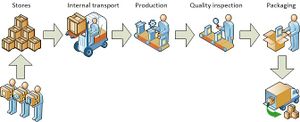Production cycle
| Production cycle |
|---|
| See also |
Production cycle is used in two meanings:
- broad: a production process that begins with raw materials and ends with finished product,
- narrow: time period of the production process from raw materials to finished product.
The broad meaning is equal to concept of production process, while the narrow one describes production cycle itself as described here.
Elements of production cycle
Production cycle can be divided into:
- working period,
- break (rest) period.
Working period
- technological operations,
- natural processes,
- inspection operations,
- maintenance operations,
- transport,
- storage.

Fig. 1. The production cycle is time period of production process
Break period
- breaks arising from the organization of the production process, including:
- waiting time in magazines,
- waiting in connection with the batch processing,
- waiting in anticipation of the release of workplace.
- breaks arising from the organization of the working day, including:
- including changes of employees
- scheduling breaks
- non-working days and holidays,
- other breaks.
Documents and methods used in production cycle planning and control
Following documents are used during production cycle design:
- bill of materials,
- operations list,
- production orders,
- material and equipment orders,
- machine configuration,
Production cycle often involves various IT systems and management methods, such as:
- Manufacturing resource planning (MRP-II)
- Lean manufacturing
- Master production schedule (MPS)
- Computer-integrated manufacturing (CIM)
- Process management,
- Quality management,
- Activity-based costing, etc.
See also:
- Determining the length of the production cycle
- Optimization of the production run-length
- Serial production
References
- Cadenillas, A., Lakner, P., & Pinedo, M. (2013). Optimal production management when demand depends on the business cycle. Operations Research, 61(4), 1046-1062.
- Chase, R. B., & Aquilano, N. J. (1992). Production and operations management: A life cycle approach (6th ed., p. 186-7). Homewood, IL: Irwin.
- Chase, R. B., Aquilano, N. J., & Jacobs, F. R. (1995). Production and operations management: manufacturing and services.
- Lee, J. S., & Park, K. S. (1991). Joint determination of production cycle and inspection intervals in a deteriorating production system. Journal of the operational Research Society, 775-783.
- Umeda Y, Nonomura A, Tomiyama T (2000). Study on life-cycle design for the post mass production paradigm, Artificial Intelligence for Engineering Design, Analysis and Manufacturing, 14:2
- Production cycle in Statoil (PDF)

